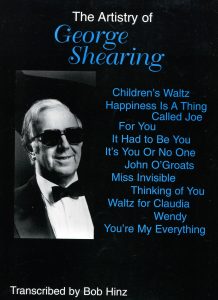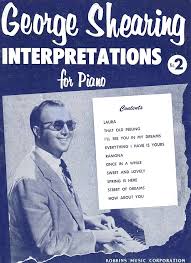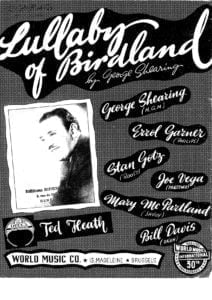Table of Contents
Come join us now, and enjoy playing your beloved music and browse through great scores of every level and styles!
Can’t find the songbook you’re looking for? Please, email us at: sheetmusiclibrarypdf@gmail.com We’d like to help you!
Remembering: Happy birthday, George Shearing, born on this day in 1919 (1919-2011).

Best Sheet Music download from our Library.

Please, subscribe to our Library.
If you are already a subscriber, please, check our NEW SCORES’ page every month for new sheet music. THANK YOU!
George Shearing: The Pianist Who Illuminated Jazz with Sound and Sophistication
George Shearing wasn’t just a jazz pianist; he was an architect of sound, a master of harmony, and a beacon of elegance whose unique approach fundamentally shaped the landscape of cool jazz and popular music for over six decades. Born blind into humble beginnings, he conquered adversity to craft a sound instantly recognizable – the shimmering, bell-like “Shearing Sound” – and left an indelible legacy defined by sophisticated arrangements, impeccable taste, and an unwavering commitment to melodic beauty.

Browse in the Library:
Or browse in the categories menus & download the Library Catalog PDF:
I. Biography: From Battersea to International Acclaim
- Early Life and Adversity (1919-1939): George Albert Shearing was born on August 13, 1919, in the Battersea district of London, England, the youngest of nine children. Blind from birth, his early world was defined by sound. His innate musical talent manifested early. He began formal piano training at the Linden Lodge School for the Blind at age three, initially drawn to classical music, particularly the complex contrapuntal works of Bach, which would later deeply influence his harmonic conception. He quickly absorbed jazz via radio broadcasts, captivated by the recordings of American pianists like Fats Waller, Teddy Wilson, Art Tatum, and Earl Hines. By his teens, he was playing accordion and piano in local pubs for modest pay, honing his craft in the demanding environment of live performance.
- Forging a Reputation in Britain (1940-1946): Shearing rapidly gained prominence in the London jazz scene during the war years. He became a featured soloist with the renowned Ambrose Orchestra and led his own popular small groups on the BBC. Collaborations with visiting American stars like violinist Stéphane Grappelli and saxophonist altoist Benny Carter solidified his reputation as Britain’s premier jazz pianist. His early recordings reveal a formidable technician deeply influenced by Tatum’s virtuosity and Wilson’s lyricism, yet already hinting at a unique harmonic sensibility.
- The American Crucible and Birth of “The Sound” (1947-1949): Seeking broader horizons, Shearing emigrated to the United States in 1947, encouraged by his first wife, Trixie Bayes, and the promise of the burgeoning New York jazz scene. The transition was challenging, requiring him to adapt stylistically and rebuild his reputation. A pivotal moment came during a 1948 performance at the Hi-Hat Club in Boston. Inspired by the Glenn Miller Orchestra’s reed section sound and the locked-hands style of Milt Buckner (pioneered by Phil Moore and others), Shearing experimented with having vibraphonist Marjorie Hyams and guitarist Chuck Wayne play his piano melody lines in unison with him. The effect was revolutionary: a pure, bell-like, harmonically rich sonority that floated above the rhythm section. This became the foundation of the George Shearing Quintet sound.
- Quintessential Success: The Capitol Years (1949-1969): Signed to Capitol Records in 1949, the classic quintet lineup solidified with Shearing (piano), Marjorie Hyams (later replaced by Margie Hyams, then Emil Richards, Don Elliott, and finally the long-serving Gary Burton), Chuck Wayne (later replaced by Dick Garcia and then the iconic Toots Thielemans), John Levy (bass), and Denzil Best (drums). Their 1949 recording of “September in the Rain,” featuring this locked-hands sound, became a surprise million-selling hit. The quintet became synonymous with sophisticated, accessible jazz. They toured relentlessly, recorded prolifically for Capitol (producing dozens of albums), and achieved remarkable mainstream popularity. Shearing’s charm, wit, and British accent added to his appeal. This period cemented his international stardom and the quintet sound as a defining element of 1950s cool jazz and cocktail lounge culture.
- Evolution and Exploration: Beyond the Quintet (1960s-1990s): While the quintet remained his primary vehicle, Shearing grew increasingly restless artistically within its constraints. He began exploring solo piano (deepening his classical influences), duos (notably with bassists like Brian Torff and Neil Swainson), and collaborations with vocalists. His partnership with the sublime Nancy Wilson produced several landmark albums (“The Swingin’s Mutual!” being a standout). He also worked extensively with Mel Tormé, forging a deep musical and personal friendship that resulted in multiple Grammy-winning albums (“An Evening with George Shearing and Mel Tormé,” 1982). This period showcased his versatility, harmonic daring, and profound skills as an accompanist.
- Later Years and Legacy (1990s-2011): Shearing continued to perform and record actively into the new millennium, though at a reduced pace. He signed with the Concord Jazz label, producing critically acclaimed albums featuring his trio (often with Neil Swainson and drummer Dennis Mackrel) and further vocal collaborations (including with Ernestine Anderson and, notably, Dianne Reeves on the Grammy-winning “Dianne Reeves and the George Shearing Quintet”). He received numerous honors, including multiple Grammys, an Ivor Novello Award, and in 2007, was knighted by Queen Elizabeth II for his services to music (becoming Sir George Shearing). He passed away peacefully from congestive heart failure on February 14, 2011, in New York City, at the age of 91.

II. Music Style: The Architecture of the Shearing Sound
Shearing’s style is a masterful synthesis of diverse influences, filtered through his unique sensibilities:
- “The Shearing Sound” (Locked-Hands Block Chords): This is his most identifiable contribution. It involved:
- Unison Melody: The piano, vibraphone, and guitar play the melody note-for-note in perfect unison. This created an incredibly pure, focused, and bell-like timbre.
- Close-Voiced Block Chords: Shearing played rich, complex chords directly under the melody note with both hands locked together. These weren’t simple triads; they were sophisticated jazz chords (7ths, 9ths, 11ths, 13ths), often voiced in close position within a single octave range for clarity and punch.
- Rootless Voicings: Crucially, Shearing frequently omitted the root of the chord from his right-hand block, relying on the bass player to supply it. This allowed the block chord to focus on the essential harmonic extensions (3rd, 7th, plus tensions like 9ths, 13ths) without muddying the texture. The vibes/guitar unison reinforced the top note (melody), while the piano’s inner notes defined the harmony. This created a harmonically dense yet crystal-clear sound.
- Harmonic Sophistication: Shearing’s harmonic language was deeply advanced and constantly evolving:
- Bach Influence: His early classical training, especially Bach’s counterpoint, instilled a profound understanding of voice leading. His chord progressions were always logical and smooth, with each note in the block chord moving purposefully to the next. This gave even his most complex harmonies a sense of inevitability and flow.
- Reharmonization: He was a master at substituting chords within standard progressions to create richer, more surprising harmonies. A simple II-V-I could be transformed with passing chords, tritone substitutions, or altered dominants, all executed with seamless voice leading.
- Modal Flavorings: Even within tonal frameworks, Shearing incorporated modal interchange (borrowing chords from parallel modes) and quartal harmony (chords built on fourths) for added color and ambiguity, especially in his later work.
- Contrapuntal Sensitivity: His lines, whether melodic or improvised, always exhibited a keen awareness of the independent movement of voices within the harmony.
- Rhythmic Precision and Swing: Despite the harmonic density, Shearing’s quintet always swung. He employed:
- Light Touch: His piano touch was precise and often delicate, avoiding heavy-handedness.
- Syncopated Comping: Behind soloists (including his own right hand), his left hand and comping provided crisp, syncopated chords that propelled the rhythm without overwhelming it.
- Guitar/Vibes Role: The guitar often provided subtle chordal punctuation (“chunking”) on the backbeats, while the vibes added sustained color. The bass and drums maintained a steady, propulsive but unobtrusive swing foundation (Denzil Best’s brushwork was particularly integral to the early quintet sound).
- Melodic Lyricism: Above all, Shearing was a melodist. His improvisations, while harmonically complex, always prioritized singable, lyrical lines. His touch and phrasing imbued even simple melodies with warmth and grace. This innate lyricism made his music accessible without sacrificing sophistication.

III. Improvisational Approach and Signature Licks
Shearing’s improvisation was an extension of his harmonic conception:
- Voice-Leading Driven: His lines weren’t just scales and arpeggios strung together; they were meticulously crafted melodies where each note resolved logically within the underlying chord changes, often outlining the essential chord tones (3rds, 7ths) and extensions (9ths, 13ths) with passing tones. He thought vertically and horizontally simultaneously.
- Block Chord Solos: He frequently employed his signature locked-hands block chord technique as an improvisational device. He would improvise entire choruses using moving block chords, creating a cascade of rich harmony where the top note was the improvised melody. This was technically demanding and harmonically brilliant.
- Contrapuntal Embellishment: Within single-note lines, he would often imply inner voices or counter-melodies through his choice of notes and phrasing, a clear legacy of Bach.
- Economy and Space: Unlike the torrential virtuosity of Tatum, Shearing valued space and melodic clarity. His solos were often concise, carefully constructed statements, favoring well-placed notes over sheer velocity, though he possessed formidable technique when needed.
- Quoting and Development: He was known for subtly weaving fragments of familiar melodies (standards, classical themes) into his improvisations, developing them seamlessly within his own harmonic context.
- Signature Licks:
- Enclosing Tones: Approaching a target note (like a chord tone) from a half-step above and below in rapid succession.
- Chromatic Approach: Using chromatic passing tones to smoothly connect chord tones or scale degrees.
- Delayed Resolution: Suspending a dissonant note (like a 4th or 9th) over a chord change before resolving it satisfyingly to a consonant tone in the new harmony.
- Upper Structure Triads: Improvising lines based on triads built on the higher extensions of a chord (e.g., playing a D major triad over a C7 chord, implying C7#11).
- Pentatonic Embellishment: Using pentatonic scales fluidly within more complex harmonic settings.
IV. Chord Progressions and Harmonic Language: A Closer Look
Shearing didn’t invent new progressions but revolutionized how standard progressions were voiced and reharmonized:
- Standard Reharmonized: Take “I Cover the Waterfront.” Shearing might:
- Replace a simple Cmaj7 with Cmaj9(#11) or C6/9.
- Turn a basic G7 into G13(b9) or use a tritone substitution (Db9) for dramatic effect before resolving to C.
- Insert passing diminished or augmented chords between diatonic changes for added tension and color.
- Use secondary dominants (e.g., D7 before G7 in the key of C) more frequently and with richer voicings.
- Rootless Voicing in Action: On a Cmaj7 chord, Shearing’s right hand block might play E-G-B-D (3rd, 5th, 7th, 9th) without the root C. The bass player provides the root. This voicing is compact, harmonically rich (Cmaj9), and clear. He had countless such voicings for every chord type.
- Quartal Harmony: In later years, especially in modal contexts or for atmospheric effect, Shearing used chords built on stacked fourths (e.g., D-G-C-F). These created a more open, ambiguous sound compared to traditional tertian harmony.
- Modal Interchange: He might borrow a chord from the parallel minor, like using an Abmaj7 (from C minor) within a piece in C major, creating a sudden, evocative harmonic shift.
- Contrapuntal Bass Lines: Even when comping, Shearing’s left hand often played moving lines that interacted contrapuntally with the right hand and the soloist, rather than just static roots and fifths.
V. Influences: The Tapestry of Inspiration
Shearing’s style was woven from many threads:
- Piano Pioneers: Art Tatum (virtuosity, harmonic daring), Teddy Wilson (lyricism, touch, swing), Fats Waller (stride, humor), Earl Hines (trumpet-style right hand), Erroll Garner (rhythmic drive, block chords), Bud Powell (bebop language, absorbed later).
- Orchestral Sounds: Glenn Miller Orchestra’s sax section (direct inspiration for the unison quintet sound).
- Classical Masters: Johann Sebastian Bach (counterpoint, voice leading, structure), Claude Debussy and Maurice Ravel (impressionistic harmony, color).
- Peers & Collaborators: The Quintet members themselves (especially Toots Thielemans’ harmonica adding a unique voice), the cool jazz aesthetic of Miles Davis (“Birth of the Cool” era), the melodic sense of Lester Young.
- Popular Song: The Great American Songbook was his core repertoire; he deeply respected the craftsmanship of composers like Gershwin, Porter, Kern, and Arlen.
VI. Legacy: The Enduring Shearing Sound
George Shearing’s impact is profound and multifaceted:
- Defining Cool Jazz: The Shearing Quintet sound became one of the most recognizable and commercially successful embodiments of the cool jazz aesthetic – sophisticated, restrained, harmonically rich, and accessible.
- Block Chord Revolution: His locked-hands technique, particularly the unison quintet approach and the use of rootless voicings, became a cornerstone of modern jazz piano pedagogy and practice. Countless pianists (Oscar Peterson, Bill Evans, Herbie Hancock, Chick Corea, Monty Alexander, Bill Charlap) studied and incorporated elements of his approach.
- Harmonic Innovator: His sophisticated reharmonization techniques and mastery of voice leading expanded the harmonic palette available to jazz pianists and arrangers.
- Ambassador of Jazz: He brought jazz to vast mainstream audiences through hit records, popular nightclub performances, and television appearances without diluting its essential sophistication. He made complex harmony sound beautiful and approachable.
- Master Accompanist: His collaborations with vocalists, particularly Nancy Wilson and Mel Tormé, set a benchmark for sensitive, harmonically supportive, and creatively interactive piano accompaniment in a jazz setting.
- Blindness as Triumph: He became a globally renowned symbol of triumph over disability, proving that artistic vision transcends physical sight through sheer talent, determination, and adaptability.
VII. Major Works, Filmography, and Selective Discography
- Most Famous Compositions:
- “Lullaby of Birdland” (1952): Undoubtedly his most famous tune, written as a theme for the legendary NYC jazz club. An enduring jazz standard with a distinctive melody and chord progression.
- “Conception” (1949): A complex, harmonically adventurous bebop line that became a jazz standard, showcasing his early mastery.
- “Bop, Look and Listen”
- “The Shearing Spell”
- “Consternation”
- Filmography (Appearances): While not a film star, Shearing appeared as himself or performed in several films and TV shows, including:
- Jazz on a Summer’s Day (1960) – Legendary Newport Jazz Festival documentary.
- The Big Beat (1958)
- A Song Is Born (1948) – Brief appearance.
- Numerous television shows throughout the 50s-80s (Tonight Show, Merv Griffin, BBC specials).
- Selective Discography (Landmark Albums): Shearing recorded over 100 albums. Key highlights include:
- George Shearing Quintet (1949) – Debut Capitol album featuring “September in the Rain.”
- You’re Hearing the George Shearing Quartet (1950) – Early classic.
- The Shearing Spell (1955) – Quintessential quintet sound.
- Black Satin (1956)
- Velvet Carpet (1956)
- Blue Chiffon (1958)
- Beauty and the Beat! (with Peggy Lee) (1959) – Landmark vocal collaboration.
- White Satin (1960) – Popular orchestral collaboration.
- The Swingin’s Mutual! (with Nancy Wilson) (1961) – Essential vocal jazz.
- Nat King Cole Sings / George Shearing Plays (1961) – Posthumous Cole vocals with Shearing arrangements.
- Jazz Concert (1963) – Live recording showcasing the quintet’s power.
- Out of the Woods (1965) – Later quintet sound.
- The Heart and Soul of Joe Williams and George Shearing (1971)
- Getting In The Mood (For Love) (1981) – Trio work.
- An Evening with George Shearing and Mel Tormé (1982) – Grammy-winning live set.
- Top Drawer (with Mel Tormé) (1983)
- A Vintage Year (with Mel Tormé) (1987)
- Dexterity (1987) – Trio.
- Paper Moon: The Music of Nat Cole (with Carmen McRae) (1991)
- I Hear a Rhapsody: Live at the Blue Note (1992) – Excellent live trio.
- Walkin’: Live at the Blue Note (1995)
- Favorite Things (1997)
- Dianne Reeves and the George Shearing Quintet (1999) – Grammy-winning collaboration.
- Live at the Forum, Bath 1992 (2003) – Captures later quintet feel.
- The Rare Delight of You (with John Pizzarelli) (2002) – Fine latter-day collaboration.
VIII. Iconic Performances
Beyond specific recordings, Shearing’s performances were legendary for their consistency, elegance, and interaction:
- Quintet Performances (1950s-60s): Night after night, defining the cool jazz sound in clubs across America and the world.
- Collaborations with Nancy Wilson: Their live chemistry was electric, blending sophisticated arrangements with deep swing and vocal/piano interplay.
- Concerts with Mel Tormé: Their mutual respect and playful banter, combined with impeccable musicality, made their live shows unforgettable events.
- Solo Piano Recitals: Demonstrating his deep classical roots and profound harmonic imagination without the quintet framework.
- Trio Work (Post-1970): Showcasing his adaptability and continued growth in a more intimate, interactive setting.
George Shearing: The Sound of Sophistication
George Shearing’s journey from a blind boy in Battersea to a knighted international jazz icon is a testament to extraordinary talent, relentless determination, and boundless musical curiosity. He didn’t just play jazz; he crafted a sonic universe – the luminous, harmonically profound “Shearing Sound” – that captivated audiences for generations.
More than just a distinctive gimmick, this sound was the product of deep musical intelligence, rooted in Bachian counterpoint and the swinging language of jazz, filtered through an unparalleled sense of harmony and melody. As a pianist, arranger, composer, and collaborator, Shearing elevated elegance and sophistication to an art form. His block chord techniques revolutionized jazz piano voicing, his reharmonizations expanded the harmonic lexicon, and his collaborations with vocalists set a timeless standard.
While “Lullaby of Birdland” echoes as his most famous creation, his true legacy lies in the sheer beauty, intelligence, and enduring swing of his music – a legacy that continues to inspire musicians and delight listeners, proving that the most sophisticated sounds can also be the most profoundly beautiful. George Shearing illuminated the world of jazz not with sight, but with sound, leaving behind a body of work that shines with timeless brilliance.
Search your favorite sheet music in the category of Jazz, Blues, Soul, & Gospel.
George Shearing – Lullaby Of Birdland
Live recording of 1992 from the Munich Philharmonie George Shearing – piano Neil Swainson – bass George Shearing – Lullaby Of Birdland.
